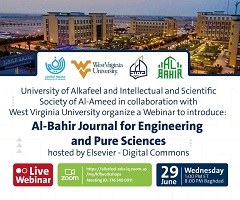Al-Bahir Journal for Engineering and Pure Sciences
Abstract
In this work, a procedure based on dispersive liquid₋liquid microextraction for lead (Pb) preconcentration and quantification in an environmental matrix by flame atomic absorption spectroscopy (FAAS) was applied. A case-study approach was chosen to obtain further in-depth information on the Pb levels. The green chemistry principles have been applied for the pretreatment and preparation of real samples by focusing on some features such as the volume of reagents/sample, employ of energy efficient equipment, and production of waste. A univariate strategy was utilized to achieve the optimum extraction conditions. 1750 µL of acetonitrile containing 100 µL of carbon tetrachloride, were rapid injection into: 12.0 mL of a sample solution adjusted the pH at 9.0 and 0.07 % (m v-1) Dithizone. The estimated limits of detection (LOD) and quantification (LOQ) under optimum conditions were 2.85 and 9.5 µg L−1, respectively. The enrichment factors EFs were found to be 60.6 (aqueous standards /DLLME₋FAAS) and 30.8 (matrix matched/DLLME₋FAAS). It was applied for the analyzing eleven environmental samples. The detectable Pb levels for water samples were ranged from 1.87 to 8.11 µg L-1, while in solid samples were ranged 0.39-4.66 µg g-1. The relative standard deviation for three concentrations (low, medium, and high) were found to be 10.64, 6.87, and 2.7, respectively. The presented system was validated by analyzing eleven environmental samples (water, bivalve molluscs, lettuce, and medicinal plants). The results indicated that high recoveries were obtained in the range of 92–104%. The lead concentration was found in these samples always lower than permissible maximum levels stipulated by Iraqi Standards Specifications 2009 (number 417) for neutral water. The DLLME/FAAS procedure has proven to be a fast, simple, low-cost, and efficient analytical protocol, therefore allowing for employing this protocol in routine analysis of trace metals in such matrixes.
Recommended Citation
Mehdi, Zaman Sahb and Alshamkhawy, Saher A. Ali
(2024)
"Univariate optimization of dispersive liquid-liquid microextraction for preconcentration of lead from environmental matrices, Samawah region prior to quantification using flame atomic absorption spectroscopy,"
Al-Bahir Journal for Engineering and Pure Sciences: Vol. 4:
Iss.
2, Article 4.
Available at: https://doi.org/10.55810/2313-0083.1058
References
[1] Wang M, Chen Z, Song W, Hong D, Huang L, Li Y. A review on cadmium exposure in the population and intervention strategies against cadmium toxicity. Bull Environ Contam Toxicol 2021;106:65-74.
[2] Rahman Z, Singh VP. The relative impact of toxic heavy metals (THMs) (arsenic (As), cadmium (Cd), chromium (Cr)(VI), mercury (Hg), and lead (Pb)) on the total environment: an overview. Environ Monit Assess July 2019; 191(7):419. https://doi.org/10.1007/s10661-019-7528-7.
[3] Dong J, Li X. Lead pollution-related health of children in China: Disparity, challenge, and policy. Sci Total Environ July 2023;882:163383. https://doi.org/10.1016/j.scitotenv.2023. 163383.
[4] Thakur A, Kumar A. Recent advances on rapid detection and remediation of environmental pollutants utilizing nanomaterials- based (bio)sensors. Sci Total Environ August 2022; 834:155219. https://doi.org/10.1016/j.scitotenv.2022.155219.
[5] Varol M, Gündüz K, Sünbül MR, Aytop H. Arsenic and trace metal concentrations in different vegetable types and assessment of health risks fromtheir consumption. Environ Res Apr. 2022;206:112252. https://doi.org/10.1016/j.envres.2021.112252.
[6] Erarpat S, Ozzeybek G, Chormey DS, Bakõrdere S. Determination of lead at trace levels in mussel and sea water samples using vortex assisted dispersive liquid-liquid microextraction-slotted quartz tube-flame atomic absorption spectrometry. Chemosphere Dec. 2017;189:180-5. https:// doi.org/10.1016/j.chemosphere.2017.09.072.
[7] Vereycken JE, Aldridge DC. Bivalve molluscs as biosensors of water quality: state of the art and future directions. Hydrobiologia Jan. 2023;850(2):231-56. https://doi.org/10. 1007/s10750-022-05057-7.
[8] Cerrato A, et al. A new software-assisted analytical workflow based on high-resolution mass spectrometry for the systematic study of phenolic compounds in complex matrices. Talanta Mar. 2020;209:120573. https://doi.org/10.1016/j. talanta.2019.120573.
[9] Mahpishanian S, Shemirani F. Preconcentration procedure using in situ solvent formation microextraction in the presence of ionic liquid for cadmium determination in saline samples by flame atomic absorption spectrometry. Talanta 2010;82(2):471-6.
[10] Sajid M. Dispersive liquid-liquid microextraction: Evolution in design, application areas, and green aspects. TrAC, Trends Anal Chem 2022:116636.
[11] Pinheiro FC, Nobrega JA. An overview of sample preparation procedures for determination of elemental impurities in medicines. Microchem J 2022:107189.
[12] Ismail SA, Afify AS. Validation and measurement uncertainty of rapid and simultaneous determination of 19 elements in drinking water using ICP-MS. Accred Qual Assur 2022;27(5):299-311.
[13] Perelonia KBS, Benitez KCD, Banicod RJS, Tadifa GC, Cambia FD, Montojo UM. Validation of an analytical method for the determination of cadmium, lead and mercury in fish and fishery resources by graphite furnace and Cold Vapor Atomic Absorption Spectrometry. Food Control 2021;130: 108363.
[14] Evans EH, Pisonero J, Smith CMM, Taylor RN. Atomic spectrometry update: review of advances in atomic spectrometry and related techniques. J. Anal. At. Spectrom. 2023; 38(5):974-99.
[15] Elik A, Altunay N. Optimization of magnetic ionic based dispersive liquid-liquid microextraction of cadmium in water and food samples using experimental design prior to flame atomic absorption spectrophotometry. Sustain. Chem. Pharm. 2022;27:100697.
[16] Karuk Elmas SN. A simple and rapid determination of Al(III) in natural water samples using dispersive liquid—liquid microextraction after complexation with a novel antipyrine-based Schiff base reagent. Environ Monit Assess Jan. 2022; 194(1):47. https://doi.org/10.1007/s10661-021-09701-y.
[17] Altunay N, Elik A, Gürkan R. Monitoring of some trace metals in honeys by flame atomic absorption spectrometry after ultrasound assisted-dispersive liquid liquid microextraction using natural deep eutectic solvent. Microchem J 2019;147:49-59.
[18] Roberta Nogueira da Silva K, Santos Pereira H, Aragao do Nascimento V, Raposo Jr JL. A greener sample preparation procedure using reverse-phase dispersive liquide—liquid microextraction for multielement determination of inorganic species in petroleum-derived samples. Fuel March 2024;359:130336. https://doi.org/10.1016/j.fuel.2023.130336.
[19] Karatepe A, Yemen M, Kayapa F, Yõlmaz E, Karipcin F, Soylak M. Vortex-assisted restricted access-based supramolecular solvent microextraction of trace Pb(II) ions with 4- (benzimidazolisonitrosoacetyl)biphenyl as a complexing agent before microsampling flame AAS analysis. Talanta October 2022;248(June):123651. https://doi.org/10.1016/j. talanta.2022.123651.
[20] Chaikhan P, Udnan Y, Ampiah-Bonney RJ, Chaiyasith WC. Air-assisted solvent terminated dispersive liquide—liquid microextraction (AA-ST-DLLME) for the determination of lead in water and beverage samples by graphite furnace atomic absorption spectrometry. Microchem J March 2021; 162(2020):105828. https://doi.org/10.1016/j.microc.2020.105828.
[21] Ullah N, Tuzen M. A comprehensive review on recent developments and future perspectives of switchable solvents and their applications in sample preparation techniques. Green Chem 2023;25(5):1729-48. https://doi.org/10.1039/ D3GC00020F.
[22] Ferreira VJ, Virgens FBS, Pires LN, Dias F de S, Lemos VA, Teixeira LSG. Liquid-phase extraction combined with X-ray fluorescence spectrometry for the elemental determination. Appl Spectrosc Rev Oct. 2023;58(9):610-28. https://doi.org/ 10.1080/05704928.2022.2113537.
[23] Silveira JRK, Brudi LC, Waechter SR, Mello PA, Costa AB, Duarte FA. Copper determination in beer by flame atomic absorption spectrometry after extraction and preconcentration by dispersive liquide—liquid microextraction. Microchem J Jan. 2023;184:108181. https://doi.org/10.1016/j.microc.2022. 108181.
[24] Al-Saidi HM, Emara AAA. The recent developments in dispersive liquide—liquid microextraction for preconcentration and determination of inorganic analytes. J Saudi Chem Soc Dec. 2014;18(6):745-61. https://doi.org/10.1016/j.jscs. 2011.11.005.
[25] Ozzeybek G, Sahin _I, Erarpat S, Bakirdere S. Reverse phase dispersive liquide—liquid microextraction coupled to slotted quartz tube flame atomic absorption spectrometry as a new analytical strategy for trace determination of cadmium in fish and olive oil samples. J Food Compos Anal 2020;90:103486.
[26] Talaee M, Lorestani B, Ramezani M, Cheraghi M, Jameh- Bozorgi S. Tandem dispersive liquide—liquid microextraction coupled with micro-sampling flame atomic absorption spectrometry for rapid determination of lead (II) and cadmium (II) ions in environmental water samples. Int J Environ Anal Chem 2019;99(12):1235-46.
[27] Trindade JS, Lemos VA, Mata Cerqueira UMF, Novaes CG, Araujo SA, Bezerra MA. Multivariate optimization of a dispersive liquid-liquid microextraction method for determination of copper and manganese in coconut water by FAAS. Food Chem Dec. 2021;365(June):130473. https://doi. org/10.1016/j.foodchem.2021.130473.
[28] Bulut VN, Bahadõr Z, Ceylan S¸ , Soylak M. A strategy based on the dispersive liquid-liquid microextraction of cadmium in environmental samples prior to õts determination by flame atomic absorption spectrometry. 2018.
[29] Lemos VA, Junior IVS, Santos LB, Barreto JA, Ferreira SLC. A New Simple and Fast Method for Determination of Cobalt in Vitamin B12 and Water Samples Using Dispersive Liquid- Liquid Microextraction and Digital Image Analysis. Water Air Soil Pollut July 2020;231(7):334. https://doi.org/10.1007/ s11270-020-04680-1.
[30] Kafa EB, Fõrat M, Chormey DS, Turak F, Bakõrdere S. Sensitive determination of cadmium in lake water, municipal wastewater and onion samples by slotted quartz tube-flame atomic absorption spectrometry after preconcentration with microextraction strategy. Measurement 2018;125:219-23.
[31] Polat N. Determination of Lead in Urine by Slotted Quartz Tube (SQT) e Flame Atomic Absorption Spectrometry (FAAS) Following Preconcentration by Dispersive Liquid Phase Microextraction (DLLME). Anal Lett Jan 2022;55(1): 47-56. https://doi.org/10.1080/00032719.2021.1914645.
[32] Xu D, Tan X, Chen C, Wang X. Removal of Pb(II) from aqueous solution by oxidized multiwalled carbon nanotubes. J Hazard Mater Jun. 2008;154(1e3):407-16. https://doi.org/10. 1016/j.jhazmat.2007.10.059.
[33] Wu D, Hu Y, Cheng H, Ye X. Detection Techniques for Lead Ions in Water: A Review. Molecules Apr. 2023;28(8):3601. https://doi.org/10.3390/molecules28083601.
[34] Pytlakowska K, Kozik V, Dabioch M. Complex-forming organic ligands in cloud-point extraction of metal ions: A review. Talanta Jun. 2013;110:202-28. https://doi.org/10.1016/ j.talanta.2013.02.037.
[35] Zhou Q, Zhao N, Xie G. Determination of lead in environmental waters with dispersive liquide—liquid microextraction prior to atomic fluorescence spectrometry. J Hazard Mater May 2011;189(1-2):48-53. https://doi.org/10.1016/j.jhazmat. 2011.01.123.
[36] Sorouraddin SM, Farajzadeh MA, Dastoori H, Okhravi T. Development of an air-assisted liquid-liquid microextraction method based on a ternary solidified deep eutectic solvent in extraction and preconcentration of Cd(II) and Zn(II) ions. Int J Environ Anal Chem Sep. 2021;101(11):1567-80. https://doi. org/10.1080/03067319.2019.1686144.
[37] Farajzadeh MA, Azimi AR, Sorouraddin SM. Vortex-assisted Liquid-liquid Microextraction for the Extraction and Preconcentration of Mercury Using Replacement of Zn (II) by Hg (II) in Zinc Dithizonate Complex and its Indirect Determination by Flame Atomic Absorption Spectrometry. Anal Bioanal Chem Res 2022;9(4):363-71.
[38] Sato N, Mori M, Itabashi H. Cloud point extraction of Cu(II) using a mixture of triton X-100 and dithizone with a saltingout effect and its application to visual determination. Talanta Dec. 2013;117:376-81. https://doi.org/10.1016/j.talanta.2013. 08.025.
[39] Rastegar A, Alahabadi A, Esrafili A, Rezai Z, Hosseini- Bandegharaei A, Nazari S. Application of supramolecular solvent-based dispersive liquide—liquid microextraction for trace monitoring of lead in food samples. Anal Methods 2016;8(27):5533-9. https://doi.org/10.1039/C6AY01463A.
[40] Yahya M, Kesekler S, Durukan _I, Arpa Ç. Determination of prohibited lead and cadmium traces in hair dyes and henna samples using ultrasound assisted-deep eutectic solvent-based liquid phase microextraction followed by microsamplingflame atomic absorption spectrometry. Anal Methods 2021; 13(8):1058-68. https://doi.org/10.1039/D0AY02235G.
[41] Ferreira V de J, Almeida JS, Lemos VA, de Oliveira OMC, Garcia KS, Teixeira LSG. Determination of Cu, Ni, Mn, and Pb in diesel oil samples using reversed-phase vortex-assisted liquid-liquid microextraction associated with energy dispersive X-ray fluorescence spectrometry. Talanta Jan. 2021;222:121514. https://doi.org/10.1016/j.talanta.2020.121514.
[42] Habila MA, Alothman ZA, Yilmaz E, Soylak M. Dispersive liquid-liquid microextraction of lead (II) as tropaeolin OOO chelates from environmental samples prior to microsampling flame atomic absorption spectrometry. At Spectrosc. 2018;39(3):112.
[43] Saleem PH, Moinfar S, Mohammed IA. Determination of Cr and Pb in edible vegetable oils by coupling of extraction induced by emulsion breaking with dispersive liquid-liquid microextraction followed by flame atomic absorption spectrometry detection. J Food Compos Anal Dec. 2023;124: 105683. https://doi.org/10.1016/j.jfca.2023.105683.
[44] Gholami M, Faraji M, Jafarinejad S. Application of a Deep Eutectic Solvent for Dispersive Liquide—Liquid Microextraction of Trace Amount of Pb (II) in Water Samples and Determination by Microvolume UV—Vis Spectrophotometry. Arab J Sci Eng 2023. https://doi.org/10.1007/s13369-022- 07544-4.
[45] Jagirani MS, Uzcan F, Soylak M. A selective and sensitive procedure for magnetic solid-phase microextraction of lead( II) on magnetic cellulose nanoparticles from environmental samples prior to its flame atomic absorption spectrometric detection. J Iran Chem Soc May 2021;18(5): 1005-13. https://doi.org/10.1007/s13738-020-02085-9.
[46] Habila MA, Yilmaz E, Alothman ZA, Soylak M. Combination of dispersive liquideliquid microextraction and multivariate optimization for separation-enrichment of traces lead by flame atomic absorption spectrometry. J Ind Eng Chem May 2016;37:306-11. https://doi.org/10.1016/j.jiec.2016.03.037.
[47] Wei X-S, Wu Y-W, Han L-J. Determination of Lead and Cadmium in Water and Pharmaceutical Products by Inductively Coupled Plasma Optical Emission Spectrometry with Preconcentration by Thiourea Immobilized Silica. Anal Lett Apr. 2015;48(6):996-1008. https://doi.org/10.1080/00032719. 2014.966379.
[48] Naseri MT, Hemmatkhah P, Hosseini MRM, Assadi Y. Combination of dispersive liquide—liquid microextraction with flame atomic absorption spectrometry using microsample introduction for determination of lead in water samples. Anal Chim Acta Mar. 2008;610(1):135-41. https:// doi.org/10.1016/j.aca.2008.01.020.
[49] Doner G, Ege A. Determination of copper, cadmium and lead in seawater and mineral water by flame atomic absorption spectrometry after coprecipitation with aluminum hydroxide. Anal Chim Acta August 2005;547(1):14-7. https:// doi.org/10.1016/j.aca.2005.02.073.
[50] Candir S, Narin I, Soylak M. Ligandless cloud point extraction of Cr(III), Pb(II), Cu(II), Ni(II), Bi(III), and Cd(II) ions in environmental samples with Tween 80 and flame atomic absorption spectrometric determination. Talanta Oct. 2008; 77(1):289-93. https://doi.org/10.1016/j.talanta.2008.06.024.
















Indexed in: